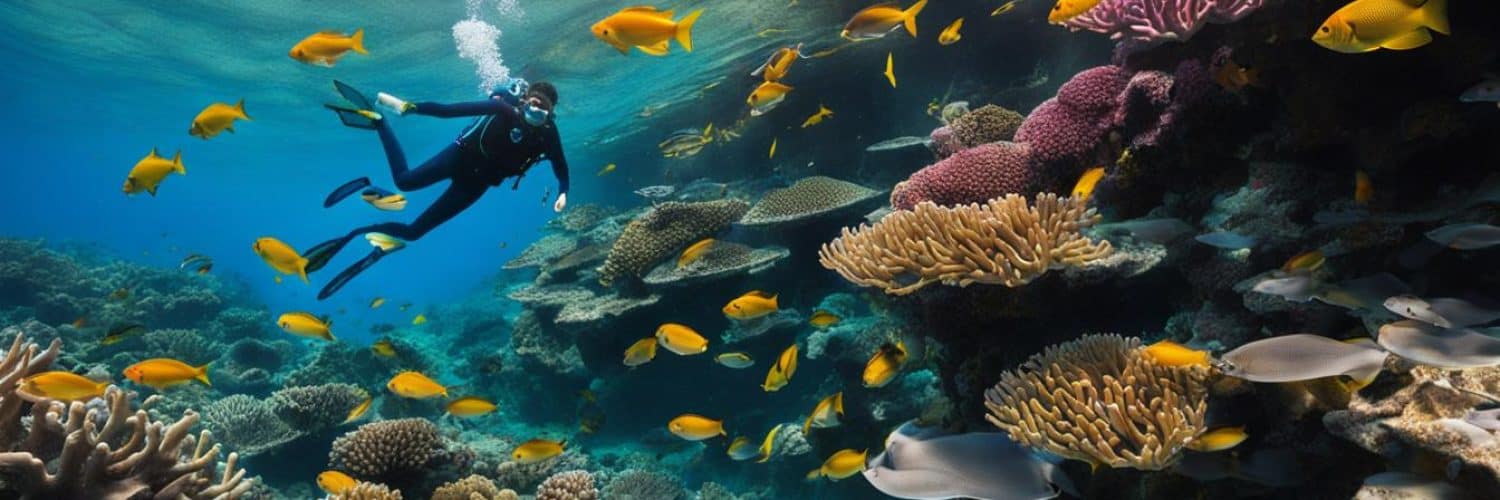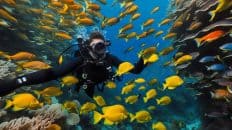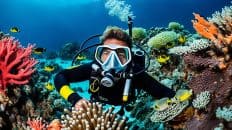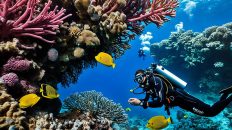Whether you’re an advanced swimmer or simply enjoy spending time in the water, snorkeling is a great way to explore the underwater world. Snorkeling is an easy and safe activity for people of all ages and experience levels. It involves breathing through a curved tube called a snorkel while being submerged and face-down under water. With the help of a mask and fins, you can see marine life, colorful corals, and more.
Snorkeling is different from scuba diving and free diving, as it requires you to stay close to the surface of the water. The history of snorkeling dates back thousands of years, with various versions of the snorkeling tube being used by ancient civilizations. Snorkeling is suitable for almost everyone, including children, the elderly, and pregnant women, as long as they are comfortable in the water.
Key Takeaways:
- Snorkeling is an easy and safe activity for people of all ages and experience levels.
- It involves breathing through a snorkel tube while being submerged and face-down under water.
- Snorkeling allows you to see marine life, colorful corals, and other underwater attractions.
- It is different from scuba diving and free diving, as it requires you to stay close to the surface of the water.
- Snorkeling is suitable for almost everyone, including children, the elderly, and pregnant women, as long as they are comfortable in the water.
What Is Snorkeling?
Snorkeling is the act of breathing through a curved tube, or snorkel, while submerged and face-down underwater. It offers a captivating opportunity to explore the vibrant marine life, colorful corals, and other fascinating underwater attractions. By using snorkeling equipment such as a snorkel tube, a mask for clear vision underwater, and fins for efficient movement, snorkelers can immerse themselves in a mesmerizing underwater world.
The snorkel tube serves as a lifeline, enabling continuous breathing through the mouth as the face remains submerged. This allows snorkelers to maintain a steady view of the underwater surroundings, giving them the freedom to observe and marvel at the diverse aquatic ecosystem. Snorkeling is a relatively low-cost activity, as it requires minimal equipment compared to scuba diving and free diving.
Snorkeling provides a unique perspective of the underwater realm, allowing individuals to connect with nature in a peaceful and exhilarating manner.
With snorkeling, enthusiasts can embark on thrilling adventures and discover the hidden gems lurking beneath the waves. Whether you’re exploring coral reefs teeming with vibrant fish or encountering majestic sea turtles gliding gracefully through the water, every snorkeling experience unveils a new dimension of beauty and wonder.
Benefits of Snorkeling:
- Opportunity to explore diverse marine ecosystems
- Accessible to people of all ages and swimming abilities
- Engaging outdoor activity that promotes physical fitness
- Relaxing and stress-relieving experience
- Enhanced understanding and appreciation of marine life
- Connection with nature and sense of tranquility
How Is It Different from Scuba Diving and Free Diving?
Snorkeling offers a unique underwater experience that sets it apart from scuba diving and free diving. While all three activities involve exploring the underwater world, they differ in terms of the equipment and techniques used.
Scuba diving requires the use of specialized scuba diving gear, including a self-contained underwater breathing apparatus (SCUBA). This equipment allows divers to stay submerged for extended periods of time and explore deeper areas of the ocean. Scuba diving offers the opportunity for more in-depth exploration of marine life, underwater caves, and reefs.
Free diving, on the other hand, is a breath-holding technique that involves diving underwater without the aid of any breathing apparatus. Free divers rely on their lung capacity and swimming skills to navigate beneath the surface. This activity requires a certain level of fitness and breath-holding ability, as free divers often push their limits to stay underwater for longer durations.
Snorkeling, on the contrary, offers a simpler and more accessible way to explore the underwater world. It involves using snorkeling gear, which typically includes a snorkel tube, mask, and fins. Snorkeling allows individuals to breathe through the snorkel tube while staying close to the surface of the water. This enables them to enjoy the beauty of the underwater world without the need for specialized training or equipment.
| Scuba Diving | Free Diving | Snorkeling | |
|---|---|---|---|
| Equipment | Self-contained underwater breathing apparatus (SCUBA) | No breathing apparatus | Snorkel tube, mask, and fins |
| Depth | Allows for exploration of deeper areas | Depends on the individual’s breath-holding ability | Stays close to the water surface |
| Skill Level | Requires specialized training and certification | Requires breath-holding ability and swimming skills | Accessible to individuals of all skill levels |
| Duration | Extended periods of time | Depends on the individual’s breath-holding ability | As long as the individual is comfortable |
A Brief History of Snorkeling
Snorkeling has a rich history dating back thousands of years. Evidence suggests that ancient divers used hollow reeds and hollow tubes to prolong their time underwater.
The modern snorkeling tube, as we know it today, was designed by Leonardo da Vinci in the 16th century. He envisioned a device that would allow divers to explore the depths of the ocean while still being able to breathe. His design consisted of a long tube with a floatation device at the surface to provide a constant supply of air.
The word “snorkel” originated from the German word “schnorchel” and was first used in English in the 1950s. It quickly gained popularity as a term to describe the tube used for breathing while swimming or diving. Today, snorkeling is a popular recreational activity enjoyed by millions of people around the world.
If you’re curious to learn more about the evolution of snorkeling equipment, take a look at the table below:
| Year | Advancement |
|---|---|
| 3000 BC | Hollow reeds used by ancient divers |
| 16th century | Leonardo da Vinci designs the first snorkeling tube |
| 1950s | The term “snorkel” becomes popular in English |
As you can see, snorkeling equipment has come a long way since its humble beginnings. With advancements in technology and materials, snorkelers today have access to a wide range of high-quality gear designed for comfort and safety.
Next, we’ll explore the importance of finding the right snorkeling equipment to ensure a great experience underwater.
Is Snorkeling for Everyone?
Snorkeling is a safe and enjoyable activity that can be enjoyed by people of all ages, as long as they are comfortable in the water. You don’t need to be an advanced swimmer to snorkel; however, it’s important to be able to float face-down comfortably and not panic if the need to come up for air arises.
Wearing glasses or contact lenses while snorkeling is possible, but it is recommended to avoid wearing glasses under the mask. Instead, opt for disposable contact lenses or a prescription snorkel mask for a clearer and more comfortable experience.
Pregnant women and individuals with mild health conditions can also participate in snorkeling, but it is advisable to consult a doctor beforehand to ensure it is safe for them. Unlike scuba diving, snorkelers do not need any certification to enjoy this activity.
Snorkeling is a great way for beginners to explore the underwater world and experience the beauty of marine life. With the right equipment, such as a snorkel tube, mask, and fins, snorkeling can be a safe and enjoyable adventure. It’s important to prioritize snorkeling safety and follow basic guidelines, such as snorkeling with a buddy, staying close to the shore, and being aware of the current and weather conditions.
So grab your gear and dive into the magical world beneath the surface! It’s time to embark on a snorkeling adventure and discover the wonders that await you.
Remember, snorkeling is an activity that can be enjoyed by everyone, whether you’re a beginner or have been snorkeling for years. Take the necessary precautions, choose the right equipment, and embrace the joy of exploring the underwater realm.
How Do I Find the Right Snorkeling Equipment?
To have a great snorkeling experience, it is important to have the right equipment. The essentials for snorkeling include a snorkel tube, a mask to see underwater, and fins for efficient movement. Snorkels come in different types, including the traditional snorkel, semi-dry snorkel, and dry top snorkel. The mask should fit well on your face and allow for clear vision underwater. It is recommended to practice breathing with your mask and snorkel outside of the water before snorkeling. Investing in high-quality snorkeling gear will enhance your comfort and enjoyment while snorkeling.
When it comes to finding the right snorkeling equipment, you want to ensure that each piece fits properly and suits your needs. Here are some tips to help you choose the right gear:
- Snorkel tube: Consider the different types of snorkels available and choose one that suits your personal preference. The traditional snorkel is a simple tube that allows you to breathe while submerged. Semi-dry snorkels have a splash guard to prevent water from entering the tube. Dry top snorkels have a valve at the top that automatically closes when submerged, preventing water from entering.
- Mask: Look for a snorkel mask that fits well on your face and provides a clear field of vision underwater. The mask should create a seal around your face to prevent leakage. Test the mask by pressing it against your face without using the strap. If it stays in place without falling off, it’s a good fit.
- Fins: Choose snorkel fins that are comfortable and fit securely on your feet. Fins should provide enough propulsion in the water without causing discomfort. Look for adjustable straps to ensure a snug fit.
Before heading out for your snorkeling adventure, practice using your mask and snorkel outside of the water. This will help you get used to breathing through the snorkel and ensure that the mask provides a proper seal. Investing in high-quality snorkeling gear will enhance your comfort and enjoyment while snorkeling, so choose gear that is durable and designed for underwater exploration.
Conserving Energy and Air While Snorkeling
Snorkeling is a physically demanding activity that requires energy and efficient use of air. By implementing certain techniques, you can conserve energy and enhance your snorkeling experience. Here are some tips to help you maximize your energy and air conservation while snorkeling:
- Relaxation and Steady Movements: Focus on staying calm and relaxed in the water. Tense muscles consume more energy and oxygen. Use slow and steady movements to propel yourself forward, allowing your fins to do most of the work.
- Deep Breathing: Take deep breaths before and during snorkeling to fully oxygenate your lungs. Breathe deeply and slowly while underwater to maximize your air intake and minimize exertion.
- Breath-Holding Techniques: Practice breath-holding techniques to increase your time underwater. As you build up your lung capacity and comfort level, you’ll be able to extend your bottom time gradually. Remember to avoid pushing your limits and always prioritize safety.
- Timely Resurfacing: Come up for air well before you reach the point of running out of air. Resurfacing early allows your body to replenish the oxygen levels and helps avoid unnecessary tiredness.
- Gradual Bottom Time Extension: With each dive, slowly extend your bottom time as your stamina and comfort level increase. Start with shorter durations and gradually work your way up to longer snorkeling sessions.
By applying these snorkeling techniques, you’ll conserve energy, maintain a steady air supply, and enjoy a more prolonged and comfortable time exploring the underwater world.
Now, let’s take a look at a table comparing different energy conservation techniques for snorkeling:
| Technique | Description | Effectiveness |
|---|---|---|
| Relaxation and Steady Movements | Focusing on being relaxed and using slow, steady movements instead of excessive force. | High |
| Deep Breathing | Taking deep breaths before and during snorkeling to maximize air intake. | Moderate |
| Breath-Holding Techniques | Practicing breath-holding techniques to extend time underwater. | High |
| Timely Resurfacing | Coming up for air well before running out of air to replenish oxygen levels. | Moderate |
| Gradual Bottom Time Extension | Gradually increasing the duration of each snorkeling session. | High |
Remember, conserving energy and air while snorkeling allows you to have a more enjoyable and sustained experience in the mesmerizing underwater world.
Best Places for Snorkeling
Looking to explore the enchanting underwater world? Here are some of the best snorkeling destinations and spots that will leave you breathless. Whether you’re a seasoned snorkeler or a beginner, these locations offer incredible opportunities to witness marine life up close and personal.
Cabo San Lucas, Mexico
Blessed with warm waters and a thriving sea lion colony, Cabo San Lucas is a paradise for snorkeling enthusiasts. Dive into the clear blue waters of the Sea of Cortez and witness the vibrant underwater ecosystem. Explore the breathtaking coral reefs and swim alongside exotic marine creatures.
Tulamben, Bali
For an unforgettable snorkeling adventure, head to Tulamben in Bali. Here, you have the unique opportunity to snorkel around the wreckage of a World War II ship. Immerse yourself in history as you marvel at the marine life thriving in and around the coral-covered wreck.
Palau, Micronesia
Prepare to be amazed at Jellyfish Lake in Palau. Plunge into the crystal-clear waters and swim among millions of harmless jellyfish. Witness the mesmerizing dance of these translucent creatures in their natural habitat.
Silfra, Iceland
Experience the wonders of Silfra in Iceland, where you can snorkel between tectonic plates. This unique location offers the chance to dive into crystal-clear water and explore the mesmerizing underwater scenery. Be awe-inspired by the breathtaking visibility as you navigate through the underwater canyons.
These snorkeling destinations provide unparalleled opportunities to immerse yourself in the beauty of the underwater world. Explore the wonders of marine life, colorful corals, and captivating landscapes in these stunning locations.
Embark on your next snorkeling adventure and create unforgettable memories in these extraordinary snorkeling spots.
Conclusion
Snorkeling offers a unique opportunity to embark on exciting underwater adventures and explore the captivating beauty of marine life and colorful corals. Whether you are just starting out or have years of experience, snorkeling provides endless opportunities for underwater exploration.
With the right snorkeling gear, such as a snorkel tube, a well-fitting mask, and efficient fins, you can enjoy a safe and enjoyable snorkeling experience. It is important to practice proper breathing techniques, conserve energy, and maintain awareness of your surroundings to make the most of your snorkeling adventures.
Snorkeling is a recreational activity that can be enjoyed by people of all ages, from children to the elderly. It does not require any certifications and is a great way to connect with nature and discover the wonders that lie beneath the waves.
So grab your snorkeling gear, dive into the crystal-clear waters, and embark on an unforgettable underwater journey. Whether you choose to explore coral reefs, swim with exotic fish, or discover hidden underwater landscapes, snorkeling will surely leave you with memories to last a lifetime.
FAQ
What is snorkeling?
Snorkeling is the act of breathing through a curved tube, or snorkel, while submerged and face-down underwater. It allows you to see marine life, colorful corals, and other underwater attractions.
How is snorkeling different from scuba diving and free diving?
Snorkeling differs from scuba diving and free diving in terms of the equipment and techniques used. Scuba diving involves carrying a self-contained underwater breathing apparatus (SCUBA) for extended periods of time, whereas free diving requires holding your breath while underwater. Snorkeling, on the other hand, relies on breathing through a snorkel while staying close to the surface of the water.
What is the history of snorkeling?
Snorkeling has a rich history dating back thousands of years. Evidence suggests that ancient divers used hollow reeds and tubes to prolong their time underwater. The modern snorkeling tube was designed by Leonardo da Vinci in the 16th century.
Is snorkeling suitable for everyone?
How do I find the right snorkeling equipment?
To have a great snorkeling experience, it is important to have the right equipment. The essentials include a snorkel tube, a mask to see underwater, and fins for efficient movement. Snorkels come in different types, including the traditional snorkel, semi-dry snorkel, and dry top snorkel. The mask should fit well on your face and allow for clear vision underwater.
How can I conserve energy and air while snorkeling?
Relaxation and slow, steady movements are key to conserving energy while snorkeling. Letting your fins do the work will help propel you forward with less effort. Taking deep breaths and breathing deeply and slowly will help maximize your air intake and keep your heart rate down. Don’t forget to come up for air well before you run out of air.
Where are the best places for snorkeling?
There are many stunning snorkeling destinations around the world. Some popular spots include Cabo San Lucas in Mexico, Tulamben in Bali, Palau in Micronesia, and Silfra in Iceland. These destinations offer unique and breathtaking snorkeling experiences for enthusiasts.







Add comment